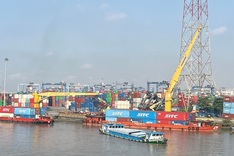>> Economic housing plan for HCMC thrown out
According to the Deputy Minister of Construction, economic apartment housing is a concept that should be put into action in Ho Chi Minh City.
 |
| A 20 square metre display apartment at Dat Lanh Real Estate Company. (Photo: SGTT). |
The plan to build economic apartments has been a topic of debate since May, when the Ministry of Construction issued a formal statement to Ho Chi Minh City’s People’s Committee about the matter.
The Ministry recommended the committee review Dat Lanh Real Estate Company’s proposed plan to build small apartments of 20 to 45 square metres on a trial basis, and subsequently, use it to draw up conclusions so that provisions of current law can be amended to suit reality.
After this information was announced, many expressed opposition to the idea. The Ho Chi Minh City People’s Committee, at the end of June, formally rejected this proposal for citing that it violates the current housing laws, but also, is likely to break the city’s sustainable development plans.
Ho Chi Minh City is currently expecting the average housing area to increase up to 26.9 square metres per person in 2015. Thus, the proposed project will go against the target and guidelines of the city.
Furthermore, the city’s Department of Construction is concerned that the building of economic apartments will have an impact on the city’s development in the sense that it would encourage immigrants, increase the urban population, put pressure on the traffic and public infrastructure, and affect the city’s social order.
Nguyen Tan Ben, Director of Ho Chi Minh City’s Department of Construction, commented, “The actual number of single people will change over time. They might be single at the time they buy an apartment but a few years later, when they start a family, it’s impossible to disallow their partner to move in with them.”
Some fear that the development of this type of economic housing will create favourable conditions for slums to spawn in the future.
The case for economic housing
According to Nguyen Tran Nam, Deputy Minister of Construction, the current law, in which the minimum housing area must be 45 square metres, does not match the people’s demand.
“Many young couples and single people are looking for an affordable place to live. A recent report announced that 14% of Ho Chi Minh City’s urban population have to rent, and we could certainly see how high the demand is,” Nam remarked.
In response to a question that addressed the shortcomings of population growth in tiny apartments, Deputy Minister Nam said, “Living in or not living in a 20 square metre apartment, people would still want to start a family. When the child grows up, if they didn’t have anywhere else to move to, they would remain in the same place with their parents. It’s inevitable.”
“Clearly, the number of square metres per person, does not depend on the apartment’s structure, but on the people and how they arrange the space for themselves. They will move out when they can afford a more spacious place to stay,” added Nam.
In reality, economic apartments with an area of 20 square metres or less, are still common in developed countries such as Korea, Hong Kong, Australia, France and America. However, with the living standard that these countries have, small apartments are not considered slums.
According to Tran Nhu Trung, Associate Director of Research at Real Estate Service Provider Savills Vietnam, it is not reasonable to refer to all economic apartments as slums, because it doesn’t just depend on the housing area alone, but also, living circumstances, occupations and the levels of education of the people living in it as well.
Deputy Minister of Construction Nguyen Tran Nam: Propose for the law to be amended Apartments with an area of 20 square metres are a suitable option for single people. Real esate investors, if they want to sell this type of apartment, it must accommodate public demand. The current housing law, perhaps, will soon be modified to not specify a minimum housing area. |




















